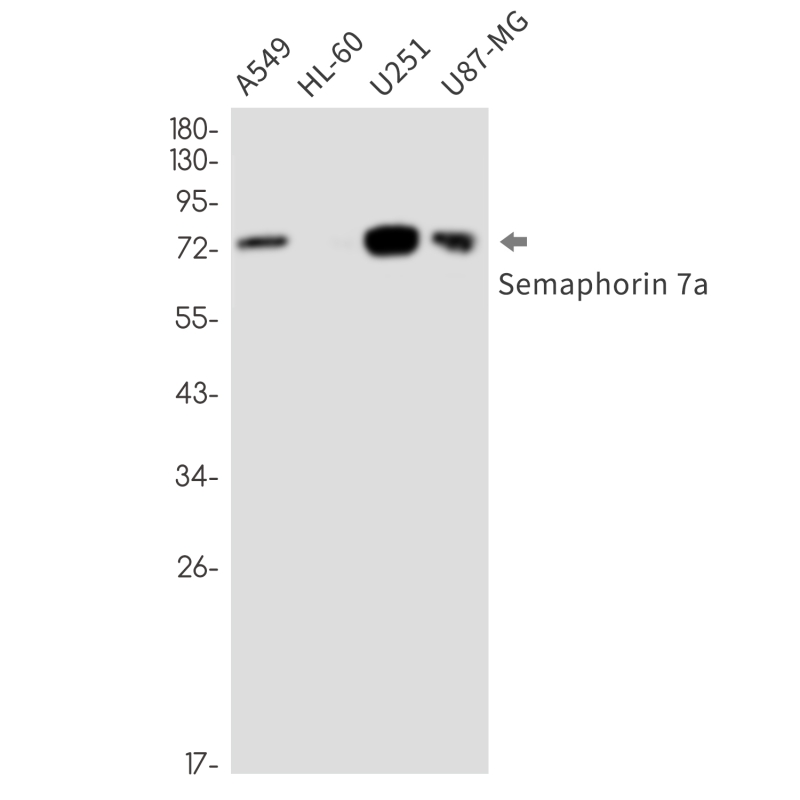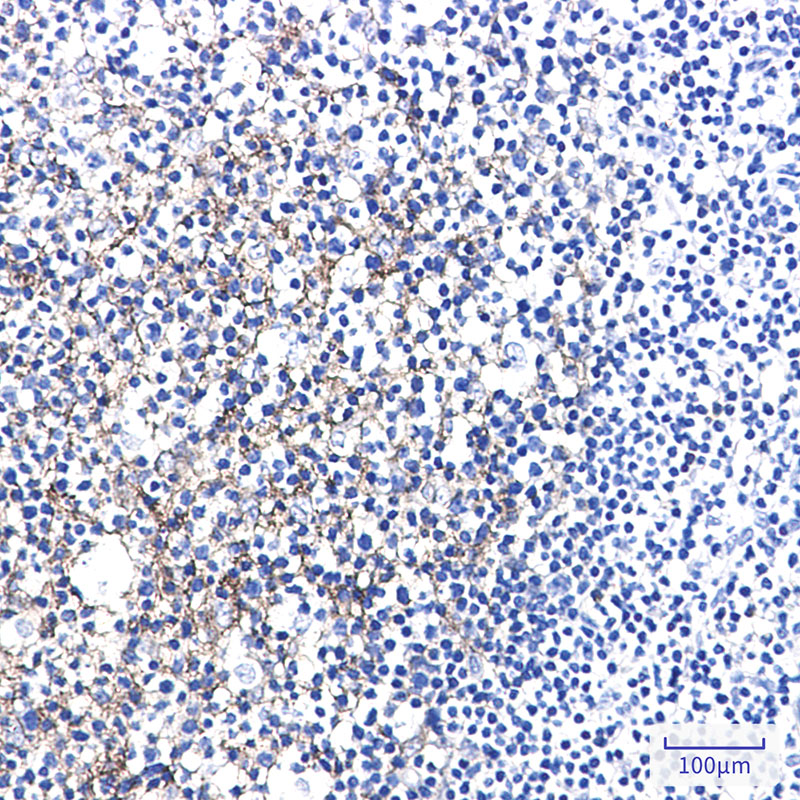

| WB | 1/500-1/1000 | Human,Mouse,Rat |
| IF | 1/20 | Human,Mouse,Rat |
| IHC | 1/50-1/100 | Human,Mouse,Rat |
| ICC | 技术咨询 | Human,Mouse,Rat |
| FCM | 咨询技术 | Human,Mouse,Rat |
| Elisa | 咨询技术 | Human,Mouse,Rat |
| Aliases | JMH; CD108; SEMAL; CDw108; SEMAK1; H-Sema-L; H-SEMA-K1 |
| Entrez GeneID | 8482 |
| WB Predicted band size | Calculated MW: 75 kDa; Observed MW: 75 kDa |
| Host/Isotype | Rabbit IgG |
| Antibody Type | Primary antibody |
| Storage | Store at 4°C short term. Aliquot and store at -20°C long term. Avoid freeze/thaw cycles. |
| Species Reactivity | Human |
| Immunogen | Recombinant protein of human Semaphorin 7a |
| Formulation | Purified antibody in TBS with 0.05% sodium azide,0.05%BSA and 50% glycerol. |
+ +
以下是关于Semaphorin 7A(Sema7A)抗体的3篇参考文献,涵盖不同研究领域:
---
1. **文献名称**: *Semaphorin 7A promotes tumor growth and exerts a pro-angiogenic effect in melanoma*
**作者**: Tohyama, M. et al.
**摘要**: 该研究通过体内实验表明,Sema7A通过整合素β1信号通路促进黑色素瘤血管生成和转移。使用中和抗体阻断Sema7A后,肿瘤生长和血管形成显著受抑制,提示其作为治疗靶点的潜力。
2. **文献名称**: *Semaphorin 7A regulates T-cell-mediated inflammation in autoimmune disease*
**作者**: Suzuki, K. et al.
**摘要**: 研究发现Sema7A通过激活T细胞加剧类风湿性关节炎模型中的炎症反应。利用抗Sema7A抗体治疗后,小鼠关节炎症和病理损伤显著减轻,表明其免疫调节功能。
3. **文献名称**: *Semaphorin 7A contributes to TGF-β1-mediated lung fibrosis*
**作者**: Yazdani, S. et al.
**摘要**: 该研究证明Sema7A在肺纤维化中通过增强TGF-β1信号通路促进成纤维细胞活化。使用特异性抗体阻断Sema7A可减少胶原沉积和纤维化进展,提示其作为抗纤维化治疗策略。
4. **文献名称**: *Sema7A modulates hippocampal plasticity and cognitive function via immune pathways*
**作者**: Pasterkamp, R.J. et al.
**摘要**: 研究揭示Sema7A通过小胶质细胞调控突触可塑性和记忆形成。抗Sema7A抗体干预后,小鼠海马区神经炎症减少,认知功能改善,为神经退行性疾病提供了新机制。
---
以上文献均涉及Sema7A抗体的功能性研究,涵盖肿瘤、免疫疾病、纤维化及神经科学领域,展示了其在基础与转化医学中的潜在应用。
Semaphorin 7A (Sema7A), a member of the semaphorin protein family, is a glycosylphosphatidylinositol (GPI)-anchored membrane protein known for its dual roles in immune regulation and nervous system development. Unlike most semaphorins, Sema7A interacts with both plexin C1 and β1-integrin receptors, enabling its involvement in diverse cellular processes such as axon guidance, immune cell activation, and tissue remodeling. It is expressed in various tissues, including neurons, lymphocytes, and epithelial cells, and has been implicated in pathologies like cancer, autoimmune diseases, and neuroinflammatory disorders.
Antibodies targeting Sema7A are critical tools for studying its function and therapeutic potential. They enable detection of Sema7A expression in experimental models and clinical samples, aiding in understanding its role in disease mechanisms. For instance, studies using Sema7A-blocking antibodies have revealed its contribution to T-cell-mediated inflammation and fibrosis, suggesting potential therapeutic applications in conditions like multiple sclerosis or pulmonary fibrosis. Conversely, agonistic antibodies might exploit Sema7A’s neuroprotective or reparative properties in neural injury models.
Research utilizing these antibodies has also highlighted Sema7A’s paradoxical effects—promoting both pro-inflammatory and tissue-repair pathways—depending on cellular context and receptor engagement. This duality underscores the importance of antibody specificity in dissecting Sema7A’s complex biology. Current efforts focus on developing clinical-grade antibodies to modulate Sema7A signaling, with promising preclinical results in autoimmune and oncological settings. However, challenges remain in optimizing selectivity and minimizing off-target effects for translational applications.
×